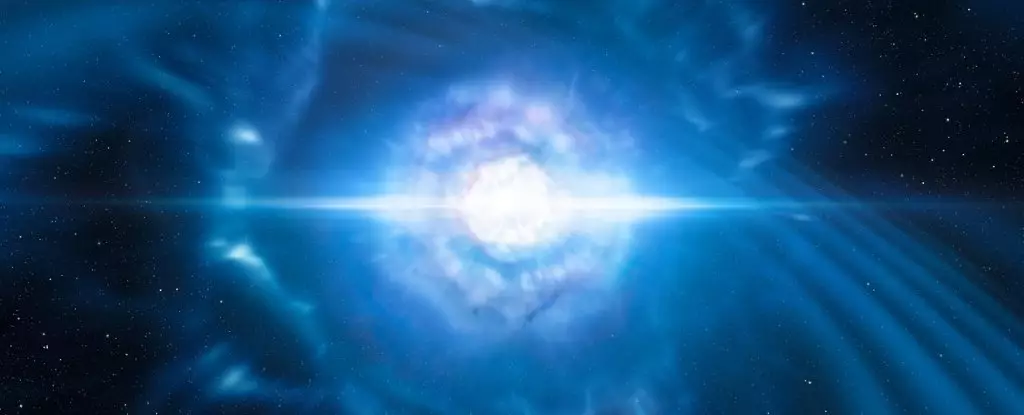The confluence of neutron stars is a phenomenon that has captivated scientists since the moment of its prediction. In the summer of 2017, this theoretical spectacle became a reality when astronomers observed the transformative collision of two neutron stars, leading to an extraordinary cosmic event known as a kilonova, designated AT2017gfo. The nuanced interplay of gravitational waves and electromagnetic radiation generated by this cataclysmic merger not only expanded our understanding of astrophysical processes but also raised tantalizing questions about the origins of heavy elements in the universe.
The neutron star collision that resulted in AT2017gfo was marked by a violent explosion releasing a burst of energy equivalent to that produced during the birth of massive stars. This kilonova did not simply announce its presence through gravitational waves; it also enveloped the cosmos in a luminous fireball that bore testament to the chaotic aftermath of matter and energy dynamically interacting. Observations of AT2017gfo provide a vivid glimpse into the raucous and extravagant processes that take place at the endpoints of stellar evolution.
Astrophysicist Albert Sneppen of the Niels Bohr Institute emphasizes the complexity of monitoring such a rapidly evolving astrophysical event. Due to the rotation of the Earth, individual observatories faced significant limitations in their ability to capture a complete picture of the kilonova in real-time. The collaborative efforts of multiple telescopes from diverse locations, including Australia and South Africa, ultimately pieced together the critical moments following this cosmic explosion, enabling a detailed analysis of its evolution.
One of the most consequential revelations from the observations of AT2017gfo is its role as a prolific source of heavy elements, including strontium and yttrium. In stellar environments, fusion processes create elements up to iron, however, the fusion energy required to form heavier elements exceeds what can be generated through stellar nucleosynthesis. Traditional models credit supernovae as the primary heavy element forge, but AT2017gfo challenged this notion, introducing neutron star mergers as another dynamic generator of r-process elements.
The kilonova’s environment reached staggering temperatures in the billions of degrees Fahrenheit, akin to the conditions prevailing during the Big Bang. In this extreme setting, particles became unbound and freely roamed, allowing for a myriad of interactions. As the kilonova expanded and gradually cooled, elementary particles collided and coalesced into atoms, marking a moment of cosmic significance. This remarkable process mirrors the Epoch of Recombination, which occurred approximately 380,000 years post-Big Bang, when the universe cooled sufficiently to permit light to travel freely and facilitate the formation of stable atomic structures.
What does this cosmic birth of atoms during a kilonova reveal about the history of our universe? The parallels between the formation of atoms post-kilonova and the Epoch of Recombination are striking. During this early period, the primordial plasma began to coalesce, allowing light to permeate space unimpeded. The insights garnered from kilonovae suggest that we may possess geometrically miniature laboratories for investigating the processes inherent in the evolution of the cosmos.
Astrophysicist Rasmus Damgaard articulates the significance of observing this process in real-time: “For the first time, we see the creation of atoms, we can measure the temperature of the matter and see the micro-physics in this remote explosion.” The ability to witness the sequential phases of atomic formation provides an unprecedented opportunity that cosmic observers have long desired. Each observation brings humanity one step closer to unraveling the mysteries cloaked in the annals of the universe’s history.
The implications of AT2017gfo extend far beyond the mere observation of a kilonova. This event provides us with a framework through which we may gain insights into cosmic evolution, stellar lifecycle phenomena, and the genesis of the elements that constitute our universe. The study of such extraordinary events allows astronomers to refine theoretical models, ultimately enhancing our grasp of the cosmos.
The observations surrounding the merger of neutron stars and the resulting kilonova, AT2017gfo, offer profound insights into the processes driving the universe’s evolution. The synthesis of heavy elements in this explosive environment introduces new pathways for understanding atomic formation, fundamentally altering our perceptions of nucleosynthesis in the universe. As we observe the aftermath of these celestial collisions, we are not merely spectators; we are participants in the unfolding story of the cosmos—a tale that is as much about our origins as it is about the universe itself.


Leave a Reply